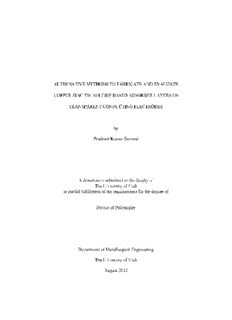
alternative methods to fabricate and evaluate copper zinc tin sulfide based absorber layers on ... PDF
Preview alternative methods to fabricate and evaluate copper zinc tin sulfide based absorber layers on ...
ALTERNATIVE METHODS TO FABRICATE AND EVALUATE COPPER ZINC TIN SULFIDE BASED ABSORBER LAYERS ON TRANSPARENT CONDUCTING ELECTRODES by Prashant Kumar Sarswat A dissertation submitted to the faculty of The University of Utah in partial fulfillment of the requirements for the degree of Doctor of Philosophy Department of Metallurgical Engineering The University of Utah August 2012 Copyright © Prashant Kumar Sarswat 2012 All Rights Reserved The University of Utah Graduate School STATEMENT OF DISSERTATION APPROVAL The dissertation of Prashant Kumar Sarswat has been approved by the following supervisory committee members: Michael L. Free Chair 5/21/2012 Date Approved Michael S. Moats Member 5/21/2012 Date Approved Zhigang Zak Fang Member 5/21/2012 Date Approved Hong Yong Sohn Member 5/21/2012 Date Approved Agnes Ostafin Member 5/21/2012 Date Approved and by Jan D. Miller Chair of the Department of _________________ Metallurgical Engineering and by Charles A. Wight, Dean of The Graduate School. ABSTRACT This study is focused on fabrication and characterization of Cu2ZnSnS4 (CZTS) films on transparent conducting substrate. CZTS films were synthesized using solution based methods. A specially designed sequential and single stage electrochemical method as well as spin coating method was used to grow layers of precursors. Deposition of constituent metallic layers was carried out on SnO2/F (Fluorinated tin oxide or FTO) coated glass substrates. The electrodeposited/spin coated layers were annealed in a sulfur environment to obtain CZTS. Structural, morphological and optical characterization experiments were performed using several techniques including x-ray diffraction, Raman and UV-visible spectroscopy, scanning electron microscopy, and atomic force microscopy. All characterization experiments indicated the films are single phase with a measured direct band gap of ~1.5 eV. Photocurrent response of CZTS film grown on FTO substrate was measured using alternating front illumination and rear illumination in a Eu3+/Eu2+ solution environment. The photoelectrochemical response exhibited during rear illumination is comparable to that obtained for front illumination. The promising photocurrent data for CZTS films suggest these films have potential application in a variety of photovoltaic devices. A comparative study revealed that photoelectrochemical response exhibited by the films grown on molybdenum substrate is greater than that obtained for film grown on FTO substrate. A modified form of the Gartner model to explain J-V characteristics for CZTS-electrolyte solution has been proposed. Fundamental information such as energy band gap-temperature relationship and temperature dependent study of Raman ‘A’ mode for CZTS thin films were also investigated in this research. iv DEDICATED TO ALMIGHTY TABLE OF CONTENTS ABSTRACT...........................................................................................................................iii LIST OF TABLES..................................................................................................................x LIST OF FIGURES..............................................................................................................xi PUBLICATIONS AND PRESENTATIONS................................................................xvi ACKNOWLEDGEMENTS............................................................................................xviii CHAPTER 1. INTRODUCTION...............................................................................................................1 1.1 Motivation and objectives.............................................................................................2 1.2 Research organization....................................................................................................3 1.3 References......................................................................................................................4 2. BACKGROUND AND LITERATURE REVIEW.......................................................5 2.1 Working principle of photovoltaic (PV) cells.............................................................5 2.2 CZTS crystal structure..................................................................................................6 2.3 Band gap of photovoltaic material................................................................................8 2.4 CZTS thin film nonvacuum fabrication techniques....................................................8 2.5 CZTS based thin film solar cell fabrication...............................................................10 2.6 Photovoltaic device operation.....................................................................................12 2.7 Photovoltaic device characteristics.............................................................................13 2.8 Substrate used for CZTS film growth.......................................................................15 2.9 Phase stability..............................................................................................................15 2.10 Microstructure and grain study of CZTS.................................................................15 2.11 Effect of KCN etching..............................................................................................17 2.12 Incorporation of sodium............................................................................................18 2.13 Fluorinated thin oxide as an alternative back contact............................................18 2.14 CZTS-FTO Band alignment.....................................................................................20 2.15 FTO-CZTS contact behavior....................................................................................21 2.16 Characterization of CZTS absorber material...........................................................21 2.16.1 X-ray diffraction (XRD) technique..............................................................22 2.16.2 Raman spectroscopy.....................................................................................23 2.16.3 Optical transmission spectroscopy...............................................................25 2.16.4 Hot probe method.........................................................................................26 2.16.5 Scanning electron microscopy (SEM).........................................................27 2.16.6 Atomic force microscopy (AFM)................................................................27 2.16.7 Semiconductor electrolyte interface............................................................28 2.17 Fermi level of redox electrolyte................................................................................30 2.18 References..................................................................................................................31 3. CZTS THIN FILMS ON TRANSPARENT CONDUCTING ELECTRODES BY ELECTROCHEMICAL TECHNIQUE..................................................................34 3.1 Introduction................................................................................................................34 3.2 Experimental details....................................................................................................35 3.2.1 Electrodeposition of stacked layers.................................................................35 3.2.2 Sulfurization.......................................................................................................37 3.2.3 Film characterization........................................................................................38 3.3 Results and discussion.................................................................................................39 3.3.1 Morphological characterization........................................................................39 3.3.2 Chemical analysis..............................................................................................42 3.3.3 Structural characterization................................................................................42 3.3.4 Optical and electrical characterization.............................................................43 3.4 Conclusions..................................................................................................................45 3.5 References.....................................................................................................................46 4. A FACTORIAL DESIGN OF EXPERIMENTS APPROACH TO SYNTHESIZE CZTS ABSORBER MATERIAL FROM AQUEOUS MEDIA...................................48 4.1 Introduction...................................................................................................................48 4.2 Theory............................................................................................................................49 4.3 Experiments..................................................................................................................51 4.4 Discussion......................................................................................................................51 4.5 Conclusions...................................................................................................................55 4.6 References......................................................................................................................55 5. A DEMONSTRATION OF SOL-GEL SYNTHESIZED BIFACIAL CZTS- PHOTOELECTROCHEMICAL CELL..........................................................................57 5.1 Introduction.................................................................................................................57 5.2 Experimental details.....................................................................................................59 5.3 Results and discussion..................................................................................................59 5.4 Conclusions..................................................................................................................66 5.5 References....................................................................................................................67 6. A COMPARATIVE STUDY OF CO-ELECTRODEPOSITED Cu2ZnSnS4 ABSORBER MATERIAL ON FTO AND MOLYBDENUM SUBSTRATE.............69 vii 6.1 Introduction...................................................................................................................69 6.2 Experimental procedure................................................................................................70 6.3 Results and discussion.................................................................................................72 6.4 Summary.......................................................................................................................83 6.5 References......................................................................................................................84 7. A STUDY OF INCREASED RESITIVITY OF FTO BACK CONTACT FOR CZTS BASED ABSORBER MATERIAL GROWN BY ELECTRODEPOSITION-ANNEALING ROUTE........................................................86 7.1 Introduction...................................................................................................................86 7.2 Experimental details......................................................................................................87 7.2.1 Measurements of sheet resistance....................................................................89 7.2.2 Inner thin layer coating.....................................................................................89 7.3 Discussion......................................................................................................................90 7.4 Conclusions...................................................................................................................94 7.5 References......................................................................................................................95 8. AN EVALUATION OF DEPLETION LAYER PHOTOACTIVITY IN Cu2ZnSnS4 THIN FILM..................................................................................................96 8.1 Introduction...................................................................................................................96 8.2 Experimental details......................................................................................................97 8.3 Theory............................................................................................................................98 8.4 Results and discussion................................................................................................102 8.5 Conclusions.................................................................................................................115 8.6 References...................................................................................................................115 9. TEMPERATURE-DEPENDENT STUDY OF RAMAN A MODE OF Cu2ZnSnS4 THIN FILMS................................................................................................117 9.1 Introduction................................................................................................................117 9.2 CZTS crystal structure and Raman mode.................................................................118 9.3 Experiments................................................................................................................120 9.4 Results and discussion................................................................................................121 9.4.1 Temperature dependence of Raman peak frequency.....................................124 9.4.2 Temperature dependence of linewidth............................................................127 9.5 Conclusions................................................................................................................129 9.6 References...................................................................................................................129 10. A STUDY OF ENERGY BANDGAP VERSUS TEMPERATURE FOR Cu2ZnSnS4 THIN FILMS...............................................................................................131 10.1 Introduction...............................................................................................................131 10.2 Experimental details..................................................................................................133 10.3 Results and discussion............................................................................................137 viii 10.4 Conclusions...............................................................................................................142 10.5 References.................................................................................................................144 11. CONTACT ENGINEERING FOR THE Cu2ZnSnS4-ALTERNATIVE BACK CONTACT: A PRELIMINARY EVALUATION........................................................146 11.1 Introduction...............................................................................................................146 11.2 Experiments..............................................................................................................147 11.3 Results and discussion.............................................................................................148 11.4 Conclusions...............................................................................................................156 11.5 References.................................................................................................................157 12. CONCLUSIONS AND FUTURE RESEARCH......................................................158 ix
Description: